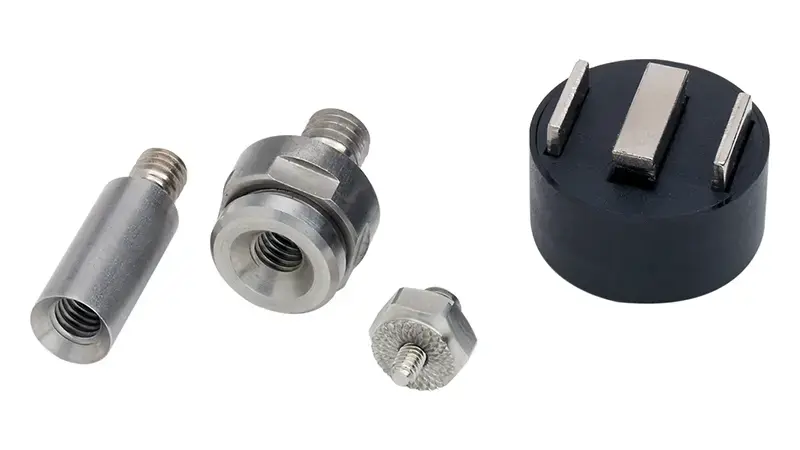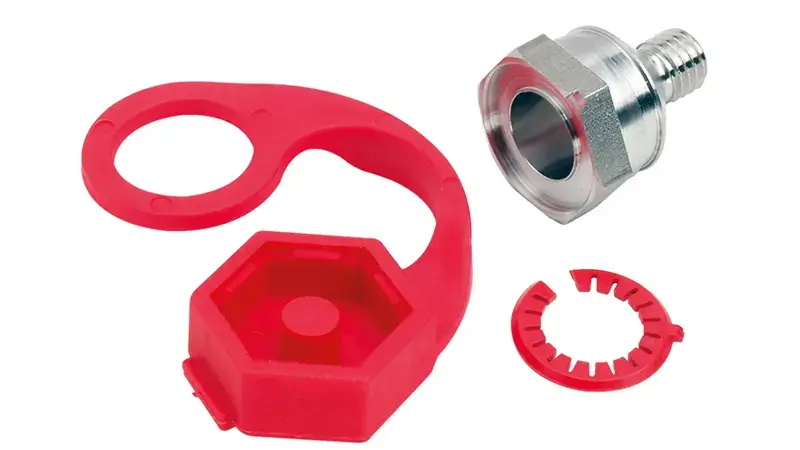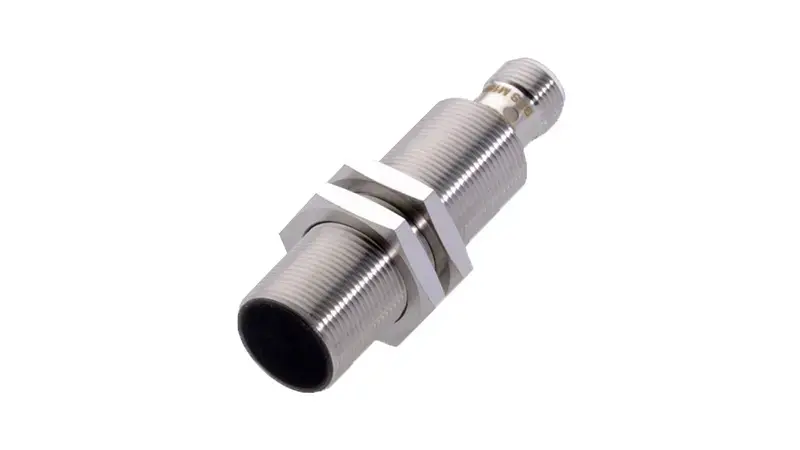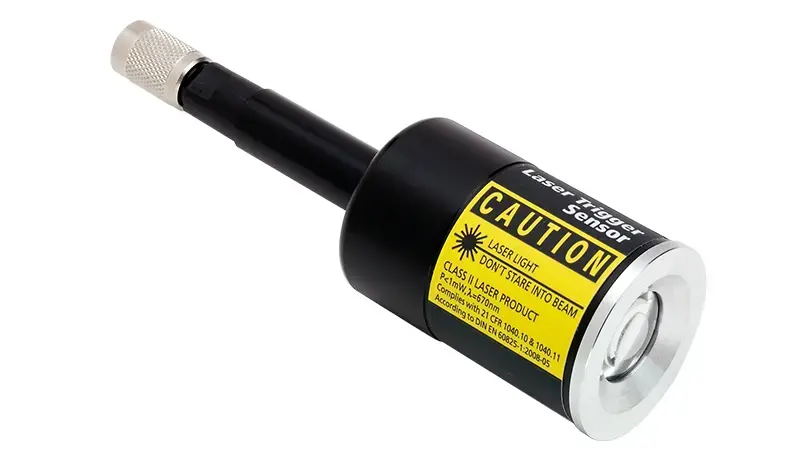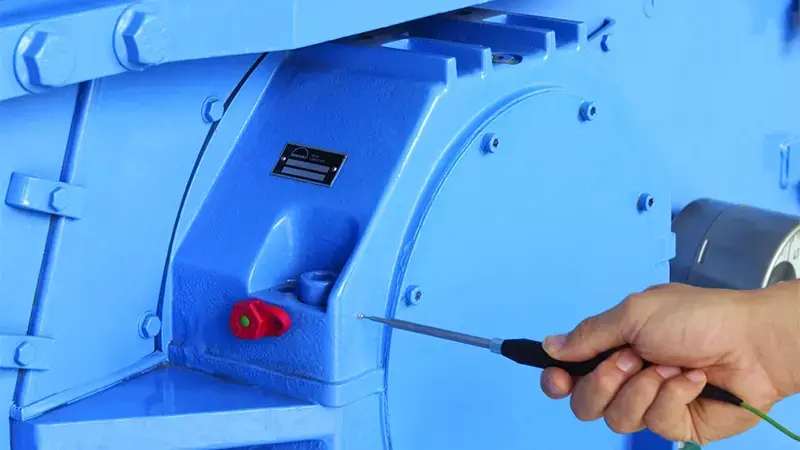Titreşim ve durum izleme için sensörler ve aksesuarlar
Geniş titreşim sensörü yelpazesi: ivmeölçer, kayma sensörü, VIBCODE dönüştürücü ve üç eksenli sensör
İvmeölçerler titreşim ivmesini, şok darbesini (makaralı yatak durumu) ve pompa kavitasyonunu ölçer
Düşük hızlı makineler için ve titreşim ile sıcaklık için çok amaçlı sensörler olarak kompakt boyutta da mevcuttur
Patentli tandem-piezo tasarımı geleneksel sensörlerin dezavantajlarını ortadan kaldırır
Akım hat takviyesi ile (CLD) sinyal yükseltme sayesinde 1.000 metreye (3.200 feet) kadar olan uzun mesafelerde kayıpsız sinyal aktarımı
Çeşitli montaj türleri
EX / ATEX yönetmeliklerine uygun şekilde temin edilebilir
Sıcaklık probları, keyphaser, kablolar, adaptörler ve araçlar mevcuttur
Ürün ayrıntılarına genel bakış
Daha fazlasını burada keşfedin …
Hassas ve güvenilir ölçüm için üniversal titreşim sensörleri
Endüstriyel ivmeölçerler
Durum izleme sistemleri için standart ivmeölçerler

VIB 6.12x, VIB 6.14x türleri
Titreşim ivmesini, şok impulsunu (makaralı yatak durumu) ve pompa kavitasyonunu ölçer
Tandem-piezo sensörü
Hat akım takviyesi ile (CLD) sinyal yükseltme
Montaj seçenekleri: yapıştırmalı, dişli, manyetik
IP68 seçeneği
EX yönetmeliğine uygun şekilde temin edilebilir
Teknik veriler (alıntı)
Frekans aralığı (±3dB) 1 Hz ... 20 kHz 0,3 Hz ... 10 kHz
Doğrusallık aralığı (±%10) 961 ms-² 450 ms-²
Hassasiyet 1µA/ms-² 5,35µA/ms-²
Rezonans frekansı 36 kHz 17 kHz
Mini sensörler
Kompakt ve ekonomik
VIB 6.202 türleri
Titreşim ivmesi, şok impulsu (makaralı yatak durumu) ve pompa kavitasyonu
Kompakt tasarım
Yer kazandıran kablo yönlendirme sistemi
Ekonomik fiyatlandırma
Tandem-piezo ölçüm elemanı
Hat akım takviyesi ile (CLD) sinyal yükseltme
Montaj seçenekleri: cıvatalı, yapıştırmalı, manyetik
EX yönetmeliğine uygun şekilde temin edilebilir
Teknik veriler (alıntı)
Frekans aralığı (±3dB) 2 Hz ... 20 kHz
Doğrusallık aralığı (±%10) 961 ms-²
Hassasiyet 1µA/ms-²
Rezonans frekansı 30 kHz
Düşük hızlı makineler
Düşük frekans ölçümü için sensörler
VIB 6.172 türleri
Çok düşük devir sayıları için: 6 devir/dak. itibariyle (=0,1 Hz)
ICP gerilim çıkışı
Montaj türleri: vidalı, yapıştırmalı
ICP kayıt birimi ayrıca patlama koruyucu versiyon olarak da mevcuttur
Teknik veriler (alıntı)
Frekans aralığı (±3dB) 0.1 Hz ... 10 kHz
Doğrusallık aralığı < 70 g (r.m.s.) (±%1)
Aktarma faktörü 100 mV/g
Rezonans frekansı 17 kHz
Triaksiyal sensorlar
Hızlı veri alımı için üç eksenli sensörler
VIBXPERT titreşim analizörü ve VIBSCANNER 2 veri toplayıcı için Typ VIB 6.655
X, Y ve Z yönlerinde eşzamanlı titreşim ölçümü
Vida bağlantısı veya mıknatıslı braket ile montaj
ICP gerilim çıkışı
Sadece VIBXPERT I ve VIBXPERT II için
Teknik veriler (alıntı)
Frekans aralığı (±3dB) 0.6 Hz ... 10 kHz
Doğrusallık aralığı (±%10) 50g (peak)
Aktarma faktörü 100 mV/g
Kolay veri alımı için sensör
Akıllı sensör ölçülecek yeri ve hangi önlemlerin alınması gerektiğini daima bilir.
Titreşim ivmesi, şok impulsu (makaralı yatak durumu) ve pompa kavitasyonu
Kolay veri toplama için kodlanmış ölçüm noktaları
Süngülü montaj aparatı ile dayanıklı bağlantı
Tekrarlanabilir sonuçlar
Tandem-piezo teknolojisi
Hat akım takviyesi ile (CLD) sinyal yükseltme
VIBSCANNER 2 ve VIBXPERT II ile uyumlu
Düşük hızlı makinelerdeki sinyalleri ölçer (>2 Hz)
VIBCODE, eğitim almamış operatörler için dahi güvenilir verilerin alınması sağlayan akıllı bir sistemdir. Tüm konumları tanır ve programlanmış ölçümleri tamamen otomatik olarak gerçekleştirir. Bu esnada trend güvenilirliğini artırırken karışıklık nedeniyle ölçümlerin yinelenmesi zorunluluğunu ortadan kaldırır.
Ölçüm sensör yuvası konum numarası ve ölçüm türü ile kodlanmıştır. Patentli özel bir prob, titreşim ile yatak durumunun (şok impulsu) mükemmel bir sinyal aktarımı ve tekrar edilebilir şekilde ölçülmesi için saplamanın üzerine kilitlenir.
Dönen makinelerde şaft titreşimi ve kayma
Endüktif deplasman sensörleri
VIBXPERT titreşim analiz cihazı
VIB 6.640 türleri
Endüktif deplasman sensörü VIB 6.640 metal nesneler arasındaki boşluğun belirli bir aralık dahilinde temassız ölçümü için kullanılır. VIBXPERT titreşim analiz cihazına bağlanır.
Temassız ölçüm
Kolay montaj
Geniş doğrusallık / çalışma aralığı
Teknik veriler (alıntı)
Çalışma aralığı Sn: 3 ... 15 mm
Maks. frekans: 300 Hz
Endüktif ölçüm prensibi
Endüktif kayma sensörü
Online durum izleme sistemleri
VIB 6.645 SET türleri
Endüktif kayma sensörü VIB 6.645 SET PRÜFTECHNIK online sistemleri ile bağlanır. Sensör belirli bir aralık dahilinde metal nesnelerin konumunu algılar.
Temassız ölçüm
Kolay montaj
Geniş doğrusallık / çalışma aralığı
Tüm çalışma alanında doğrusal voltaj sinyali
Maks. frekans yüksekliği
LED ayarlama gösterimi
Teknik veriler (alıntı)
Doğrusallık aralığı: 2 ... 10 mm
Nominal çalışma aralığı Se: 6 mm
Maks. frekans: 500 Hz
Dönmeye bağlı hızı ölçer ve titreşim analizi için referans sinyal sağlar
Lazer trigger / RPM sensörü
Veri toplayıcıları için
VIB 6.631 türleri
Mobil PRÜFTECHNIK ölçüm sistemleri için devir sayısı sensoru
Lazer optik ölçüm
Kolay montaj ve ayar
Yüksek devir sayısı ölçüm aralığı
Sağlam tripod (aksam)
Opsiyonel olarak patlama koruyucu versiyon mevcut
Teknik veriler (alıntı)
Ölçüm aralığı: 0,1 ... 600 000 devir/dak.
Ölçüm mesafesi: 0,05 ... 2 m
Çıkış: 5V (TTL)
Endüktif RPM sensörleri
Online izleme sensörleri için
VIB 5.992-NX türleri
Sabit PRÜFTECHNIK ölçüm sistemleri için standart devir sayısı sensoru
İndüktif ölçüm
Kolay montaj ve ayar
Teknik veriler (alıntı)
Ölçüm aralığı: < 150.000 devir/dak.
Ölçüm mesafesi: 2,3 ... 12 mm
Yük akımı: 200 mA
Kalıcı, portatif ya da manyetik sıcaklık probları
NiCrNi-sensörü
Veri toplayıcı için standart sıcaklık ölçüm sensörü
VIB 8.607-1.5, VIB 8.608 türleri
Zor erişilir ölçüm yerleri için
Manyetik bağlantı (VIB 8.607-1.5)
Tarama ucuna sahip el tipi sonda (VIB 8.608)
Geniş ölçüm aralığı
Patlama tehlikesi olan bölge için de mevcuttur
Teknik veriler (alıntı)
Ölçüm aralığı:
-50 ... 240°C (VIB 8.607-1.5)
-50 ... 500 °C (VIB 8.608)Hata payı: < 3%
Sensor tipi: NiCr-Ni termo couple
Uygun aksesuarlar kolay ve güvenilir ölçümler sağlar
Montaj adaptörü ve aletler
Kablo, arayüzler ve sabit sistemler için aksam
Mobil ölçüm cihazları için kablo ve bağlantı adaptörü
Müşteriye özgü çözümler
Bir ölçüm sisteminin kalitesi sadece ana bileşenlere bağlı değildir; ayrıca tüm sistem bileşenlerinde de kendisini gösterir. Ölçüm sistemlerimizi geliştirirken bu yüzden ideal uyarlanmış bir ölçüm zincirine çok önem veriyoruz; sensor sisteminden, sinyal aktarımı üzerinden sinyal hazırlama ve görüntülemeye kadar.
Son teknoloji ile ölçüm hassasiyeti
Tandem-Piezo tasarımı
PRÜFTECHNIK’in patentli Tandem-Piezo ivmeölçerlerinin benzersiz özellikleri, bu ürünü tüm endüstriyel titreşim uygulamaları için uygun kılmaktadır.
Benzersiz tasarımı sıcaklık darbelerini ve temel gerilim etkileri neredeyse yok eder. Ayrıca turbo makinelerin ve dişli kutuların, sürtünmesiz yatakların ve pompa kavitasyonun durum değerlendirmeleri ile başa çıkar. Bunun hepsini geniş bir lineer aralık ve 36 kHz’de belirlenmiş şok darbe rezonansı sayesinde tek bir transdüser ile gerçekleştirir.
Düşük temel gerilim duyarlığı, transvers duyarlılığı ve geçici sıcaklık duyarlılığı
Yüksek darbe direnci
Yükselticinin aşırı yüklenmesinden kaçınmak için entegre rezonsans bastırma filtreleri
Uzun vadeli stabilite için fabrikada ilgili kontroller ile çalışmaya hazırlanmıştır
Hat akım takviyesi (CLD)
Sabit olarak kurulmuş izleme sistemlerindeki uzun kablolar kayda değer elektrik ve mekanik girişimlere karşı koymalıdır. Gürültü ve girişimlerden gelen etkiler yüzünden geleneksel sensörler ile sinyaller sistemde kısa mesafeler iletilebiliyordu.
PRÜFTECHNIK titreşim sinyalini desteklemek için her bir sensöre takılan küçük bir elektronik yükseltici bulunan Hat akım takviyesi sistemi kullanır.
Mekanik ve elektrikli arayüze düşük hassasiyet (kablo sesi, elektromanyetik kaynaklar, topraklama döngüsü)
Çok az sinyal kaybı ile çok uzun düşük maliyetli kablolar kullanılabilir
Kurulum sırasında kablo konumlandırması kritik değildir
Titreşim sinyalinin taşındığı aynı koaksiyonel kablo boyunca taşınan güç besleme akımı (güç alıcı alete monte edilmiş olan bir kaynaktan gelir).
Voltaj çıkışı ya da akım çıkışı sağlayan sistem olmak üzere iki türlü takviye sistemi vardır. PRÜFTECHNIK sistemleri teknolojik üstünlüğünü ortaya koymak adına söz konusu bu sistemlerden ikincisini kullanır ve aşağıdaki avantajları sunar:
1.000 metrenin üzerindeki çok uzun kablolarda dahi daha az frekans kaybı.
Endüklenmiş gürültü ve topraklama döngüsü gürültüsüne daha az duyarlılık. Bu özellik çoğu durumda yalıtımlı sensör ihtiyacını da ortadan kaldırır.
FAQ
Frequently Asked Questions
What is a Vibration Sensor?
A vibration sensor is a device used to measure the vibrations emitted by equipment and assets. Vibration sensors measure levels of displacement, velocity, and acceleration.
Changes in these measurements that fall outside of a predefined threshold for normal operation can indicate a problem, such as a worn bearing, misaligned parts, or other condition that requires attention. Vibration monitoring is one of the most effective forms of condition monitoring because it can pick up on these problems months before they become serious enough to cause asset failure. This enables maintenance teams to address the problems and schedule maintenance proactively, reducing the risk of unplanned downtime.
Here's how a vibration sensor works: Every piece of rotating equipment has its own vibration signature. When a machine’s normal vibration patterns change, it may indicate a fault. Changes to vibration patterns can reveal a wide array of problems, including looseness, imbalance, or premature wear. Vibration patterns also change when your machine parts are cracked or improperly connected.
Modern vibration sensors can capture and transmit vibration data on a continuous basis, making this data available for analysis in real-time. This makes it easy for your maintenance team to see exactly what’s going on with your assets, so that they can stay a few steps ahead of your maintenance needs.
When used as part of a comprehensive predictive maintenance strategy, vibration sensors can drastically reduce downtime and increase your operation’s productivity.
What are the Different Types of Vibration Sensors?
There are a number of different
types of vibration sensors
on the market, including a variety of vibration sensing technologies, as well as both wireless and wired sensors. It is important to choose a sensor that fits your needs and your budget. The following is a high-level overview of the different types of vibration sensors on the market today.
Accelerometer Vibration Sensors
Accelerometers are the most commonly used kind of vibration sensor. They measure changes in the velocity of your assets’ vibrations.
Accelerometer vibration sensors
are highly sensitive and can pick up on even subtle changes in vibration.
There are many different kinds of accelerometers, including:
Vibration Meters are small, hand-held devices that can measure vibrations on an as-needed basis.
Vibration meters
often do not directly attach to your machinery, though some can be configured that way. Instead, technicians use them as part of routine inspections. Vibration meters often include accelerometers.
Vibration meters are convenient and accurate. However, they cannot provide data on a continuous basis, the way wireless vibration sensors can. This means that vibration meters alone can’t enable a predictive maintenance strategy.
MEMs Vibration Sensors are widely used because of their frequency response. They excel at picking up vibration frequencies between 0 and 1,000 hertz. Changes in those lower frequencies typically point to problems with imbalance, misalignment, and looseness. MEMs sensors are also cost-effective, offer a long battery life, and have high IP ratings for reliable operation in wet or dusty industrial environments.
Piezoelectric vibration sensors, also known as piezo sensors, are often lauded for their performance even in extreme environments. Piezoelectric vibration sensors also pick up on higher frequencies, especially frequencies above 1,000 hertz. Changes in these higher frequencies usually indicate problems with gearboxes and motor bars.
What is a Piezoelectric Vibration Sensor?
Piezoelectric vibration sensors use the piezoelectric effect to measure vibration by converting it into an electrical charge. These sensors rely on piezoelectric elements – usually quartz crystals – to convert the mechanical energy caused by vibrations into electrical signals.
Your technicians will place piezoelectric sensors directly on your equipment or component parts. As the asset vibrates, that movement creates an electrical charge across the piezoelectric element.
Piezo vibration sensors are probably the most widely used form of accelerometer because of their resilience, versatility, and ability to operate in harsh environments.
Why use an industrial vibration sensor?
In the past, vibration sensors were primarily used for large-scale equipment like HVACs. Today, there is more pressure than ever on manufacturers to keep up their production schedules on target and minimize downtime. Most operations are also using more assets than ever before. This makes it more challenging and complex to perform routine inspections.
As a result, more and more industrial operations have started using vibration sensors to monitor the health of their equipment. Vibration sensors alert you to potential problems like misalignment, imbalance, looseness, and gear issues. In many cases, the sensors flag these conditions months before they turn into major problems. That allows your maintenance team to get in and fix the issue ahead of time.
Vibration sensors are a key part of any condition monitoring or predictive maintenance strategy. They allow you to keep tabs on your equipment without forcing you to shut down operations for routine inspections.
You’ll know exactly when and where to replace belts, lubricate parts, or perform other routine maintenance tasks. Ultimately, you’ll save on maintenance costs and maximize your uptime and productivity.
Where do I install vibration sensors?
It’s generally a good idea to install vibration sensors on your critical assets. Vibration sensors can track the health of all of your rotating equipment, including
Motors
Fans and belts
Pumps
Gearboxes
Conveyor systems
Automated assembly lines
Chillers
When first piloting a condition monitoring program, start by installing vibration sensors on the equipment that you rely on to maintain production levels. Install the sensors as close as possible your motor, pump, and shaft bearings. If you’re not sure where or how to mount your sensors, it’s a good idea to consult with condition monitoring experts.
Daha fazla bilgi indir
Broşür
Sertifikalar
-
![]() VIB 6.2yy zz XD Minisensor
VIB 6.2yy zz XD Minisensor
Certificate | EX
-
![]() VIB 6.631 EX Laser Trigger Sensor
VIB 6.631 EX Laser Trigger Sensor
Certificate | EX
-
![]() VIB 8.660 EX VIBCODE 1.Supplement
VIB 8.660 EX VIBCODE 1.Supplement
Certificate | EX
-
![]() VIB 2.25x | 2.26x | 3.57y-x | 4.70y-x | 4.750-5 | 5.13x | 5.2xy | 5.322-x | 5.330wxyz | 5.33x | 5.34x | 5.345-6 | 5.346-MUX | 5.422 cable CM
VIB 2.25x | 2.26x | 3.57y-x | 4.70y-x | 4.750-5 | 5.13x | 5.2xy | 5.322-x | 5.330wxyz | 5.33x | 5.34x | 5.345-6 | 5.346-MUX | 5.422 cable CM
Declaration of conformity | CE
-
![]() VIB 5.332 X Keyphaser adapter for protection system
VIB 5.332 X Keyphaser adapter for protection system
Declaration of conformity | CE
-
![]() VIB 5.341...344 Adapters for VIBXPERT II
VIB 5.341...344 Adapters for VIBXPERT II
Declaration of conformity | CE
-
![]() VIB 5.433 X Adapter cable for extra low voltage VIBXPERT EX
VIB 5.433 X Adapter cable for extra low voltage VIBXPERT EX
Declaration of conformity | CE
-
![]() VIB 6.164-10 | 6420-L | 6.426-L | 6.640 | 6.675 | 7.115-x | 7.832-5 | 8.618-x | 8.619 | 8.619-USB 321926-2 cable CM
VIB 6.164-10 | 6420-L | 6.426-L | 6.640 | 6.675 | 7.115-x | 7.832-5 | 8.618-x | 8.619 | 8.619-USB 321926-2 cable CM
Declaration of conformity | CE
-
![]() VIB 6.172 ICP Beschleunigungsaufnehmer
VIB 6.172 ICP Beschleunigungsaufnehmer
Declaration of conformity | CE
-
![]() VIB 6.195 CLD Accelerometer
VIB 6.195 CLD Accelerometer
Declaration of conformity | CE
-
![]() VIB 6.1xy Ind. Accelerometer with intrinsic safety
VIB 6.1xy Ind. Accelerometer with intrinsic safety
Declaration of conformity | CE
-
![]() VIB 6.1xy Industrial Accelerometer
VIB 6.1xy Industrial Accelerometer
Declaration of conformity | CE
-
![]() VIB 6.202 - 203 Mini acceleration Sensor
VIB 6.202 - 203 Mini acceleration Sensor
Declaration of conformity | CE
-
![]() VIB 6.20y-zzXD Mini acceleration Sensor
VIB 6.20y-zzXD Mini acceleration Sensor
Declaration of conformity | CE
-
![]() VIB 6.210 ICP-Sensor with M-12 connection
VIB 6.210 ICP-Sensor with M-12 connection
Declaration of conformity | CE
-
![]() VIB 8.619-USB Serial to USB cable adapter for VIBROTIP EX
VIB 8.619-USB Serial to USB cable adapter for VIBROTIP EX
Declaration of conformity | CE
-
![]() VIB 8.660 HEX VIBCODE without cable dust explosion proof
VIB 8.660 HEX VIBCODE without cable dust explosion proof
Declaration of conformity | CE
-
![]() VIB 8.660 VIBCODE without cable
VIB 8.660 VIBCODE without cable
Declaration of conformity | CE
-
![]() VIB 6.221 Beschl.sensor Hybrid Triaxial mobil
VIB 6.221 Beschl.sensor Hybrid Triaxial mobil
Uygunluk beyanı | CE
Kılavuzlar
-
![]() RPM sensor
RPM sensor
Kullanım talimatları
-
![]() Switchbox VIB 6.785 installation
Switchbox VIB 6.785 installation
Manual
-
![]() VIB 6.12x – VIB 6.14x Industrial accelerometer
VIB 6.12x – VIB 6.14x Industrial accelerometer
Manual
-
![]() VIB 6.210 – VIB 6.172 IEPE sensor
VIB 6.210 – VIB 6.172 IEPE sensor
Manual
-
![]() VIB 6.221 Triaxial sensor
VIB 6.221 Triaxial sensor
Manual
-
![]() VIB 6.2x mini sensor
VIB 6.2x mini sensor
Manual
-
![]() VIBCODE
VIBCODE
Manual
-
![]() VIBCODE Repair instruction
VIBCODE Repair instruction
Manual
-
![]() VIBCODE Test instruction
VIBCODE Test instruction
Manual
-
![]() VIBCODE - Instructions for adhesive mounting
VIBCODE - Instructions for adhesive mounting
Manual
-
![]() VIB 6.163 Online Combi sensor
VIB 6.163 Online Combi sensor
Manual
-
![]() VIB 6.195 CLD Wind sensor
VIB 6.195 CLD Wind sensor
Manual
-
![]() Vibration Sensors Safety Information
Vibration Sensors Safety Information
Kullanım talimatları
-
![]() VIB 6.520 Accelerometer
VIB 6.520 Accelerometer
Kullanım talimatları



 PRÜFTECHNIK Proaktif Bakım
PRÜFTECHNIK Proaktif Bakım


